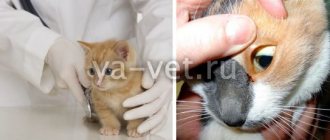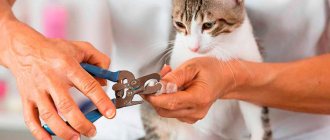When owners get a cat at home, very often the animal becomes a full-fledged member of the family. Therefore, any pet health problems do not go unattended. Owners of cats should not only pay attention to the general state of health, but also to such a feature as undescended testicles in the scrotum, or cryptorchidism. This is one of the most common problems in cats, especially purebred ones.
Features of cryptorchia
Cryptorchia is not a disease, but a pathology that is characteristic only of males. It consists in the abnormal placement of the testicles in the abdominal cavity or in the inguinal canal. In this case, the descent of the testes (one or two) into the scrotum does not occur. The animal does not have any other developmental abnormalities.
Very often cryptorchidism is confused with anorchism or monorchism. Anorchism and monorchism are congenital pathologies, in which in the first case two testicles are missing at once (therefore the cat cannot have offspring), and in the second case, one testis.
In outbred cats, cryptorchidism is observed much less frequently (on average 2% of the entire population) than in purebred cats. The probability of giving birth to a cryptorchid cat is 1:50. This indicator depends on the breeder who breeds purebred cats.
Types of pathology
Experts distinguish two main types of pathological condition, in which the egg does not descend into the scrotum, but remains in the abdominal cavity. The most common form is unilateral (right- or left-sided), and more rarely - bilateral (both testicles are hidden in the cavity or inguinal canal).
There are also types of pathology depending on the location of the testes:
- Abdominal . An extremely severe form in which the testicle is located in the abdominal cavity. It is very difficult to detect, since the testis may be hidden behind the organs. In rare cases, the situation may be complicated by testicular underdevelopment.
- Inguinal . Identifying the location of the testis is not difficult. With this type of pathology, it is located in the groin area behind the fat layer, so it can be easily felt with your hands.
- False . In this case, one or two testicles are located in the scrotum, but under severe stress caused by external stimuli, they can be retracted into the inguinal canal or abdominal cavity.
- Secondary . As a rule, it is a subtype of false cryptorchidism. But if in the false form the testes descend back into the scrotum, then in the secondary form they remain outside it.
If a cat is diagnosed with cryptorchia, surgery will be required to remove one or two testes. If the pathology is ignored, there is a high probability of subsequent degeneration of testicular tissue in the abdominal cavity into a malignant tumor.
Causes of anomalies and self-detection
It is very difficult to determine why a cat developed a pathology. Experts identify several reasons why this can happen. Factors contributing to the occurrence of cryptorchidism:
- Inheritance of mutation. It has not yet been established whether the mutation is transmitted to the offspring through the paternal or maternal line.
- Anatomical features. A very short testicular cord, the occurrence of adhesions or a narrow inguinal canal contribute to the failure of the testicle to descend into the scrotum.
- Injury while passing through the birth canal.
- The presence of infections during the cat’s pregnancy and the use of potent medications during this period.
- Hormonal disorders.
It is impossible to detect pathology at an early age. But if the kitten’s father is a cryptorchid, then there is a possibility that the anomaly will also appear in his offspring. As a rule, pathology is detected only after 6 months from birth. It is at this age that the testicles should descend into the scrotum. Therefore, at this time, cat owners are advised to take their animal to the veterinarian. Inguinal cryptorchidism is not difficult to detect. Other species are much more difficult to diagnose. Sometimes the abdominal form is very difficult to detect even with the help of ultrasound.
Pros and cons of castration
The pros and cons of castrating a cat is a list that differs from the point of view of scientists and ordinary people. Veterinarians see only positive things in the operation. Neutered cats live 1.5-2 years longer than usual, do not mark their territory and do not show aggression.
Animals stop meowing at night and become as obedient as possible. You can forget about prostate adenoma and sexually transmitted infections. They do not threaten a castrated cat. Tumor processes after surgery are also unlikely, especially if the intervention was performed on a young pet.
Cat owners also find downsides to castration, noting that many animals become obese. This is due to the laziness of those who underwent surgery. Leading a sedentary lifestyle and not being interested in the opposite sex, people with mustaches find solace in food.
However, obesity is the result of an incorrectly selected diet and diet, veterinarians note.
Doctors admit only one objective disadvantage of castration - an increased risk of developing urolithiasis. Systematic surveys are required in this regard.
Surgery to remove the testes
When a cat is diagnosed with cryptorchidism, the veterinarian will always order surgery on the animal, even if it is unilateral cryptorchidism. It is not recommended to leave one testis:
- a cryptorchid cat can pass the pathology on to its offspring;
- an animal with one testicle is usually more aggressive, so castration will solve this problem;
- Removing the testicles relieves the cat of sexual desire.
The operation should only be performed in a clinic and under no circumstances at home. This eliminates the possibility of infection entering the body. Castration occurs under general anesthesia and lasts on average 1.5-2 hours. A testicle that has descended into the scrotum is removed by the surgeon as standard, and a testicle that has not descended - depending on the type of cryptorchidia:
- Inguinal. The fur on the belly is shaved, the surgeon makes an incision and cuts off the testis. The cord is either cauterized or tied.
- Abdominal. The operation is similar to sterilizing a cat. The cut should be long. The testicle is pulled out by the vas deferens and then cut off.
Any operation ends with stitches.
Preparing the cat and progress of the operation
12 hours before the procedure, the pet should not be given food to avoid vomiting. The cat drinks water 4 hours before the clinic visit.
Working with a cat at the doctor:
- The patient is weighed and examined for external signs of a cold.
- They put him under anesthesia.
- A micro-incision is made on the scrotum, the spermatic cords are ligated, and the testicles are removed.
- A suture is usually not applied; the incision is treated with an antiseptic.
- The cat's condition is monitored until recovery from anesthesia.
Some clinics offer home surgery services. The veterinarian arrives with the necessary equipment to the location specified by the client. It is better to perform on-site surgeries on young, completely healthy cats, because in the event of complications, it will not be possible to resuscitate the animal.
If your pet quenches its thirst before surgery, there is a risk of water getting into the lungs and developing pneumonia.
The veterinarian announces the full range of examinations and how much the cat castration itself costs. Removing genitals costs less than spaying a cat.
Postoperative care
After castration, any animal requires special care. As a rule, if the operation is successful, the pet is returned to the owners on the same day. But before this, the cat must completely recover from anesthesia. Sometimes clinic workers offer a service such as postoperative care in a hospital. It involves placing the animal in a special box where the microclimate conditions are constant and optimal for the four-legged animal.
If the cat’s postoperative period takes place at home, the owners must follow certain care measures:
- The temperature in the room where the animal is located must be constant.
- There should be no drafts.
- To prevent your pet from licking or chewing the wound, it is recommended to wear a special collar.
- Sutures should be regularly treated with antiseptic agents.
- If an animal has an increase in body temperature, it is necessary to give it an antipyretic.
- It is also recommended to give the cat painkillers for several days.
- If your pet is constipated, a laxative is prescribed.
- If an animal refuses to eat for a long time, it is imperative to consult a veterinarian.
It is important to note that you should only give your cat medications those prescribed by your veterinarian. Medicines for humans (for example, Paracetamol, Drotaverine) are not intended for the treatment of animals. They can harm your pet or be fatal.
Preparation
Before the operation, the cat is examined at the clinic.
Step-by-step instructions on how to prepare a cat for castration:
- Visit the veterinarian for a full examination . The specialist examines the animal, assesses the degree of its development and readiness for removal of the reproductive organs. The cardiologist then determines your breathing rate and pulse.
- Prescribing the necessary tests to exclude existing pathologies . The standard set includes blood and urine tests, tests to identify parasites (worms, fleas) in the body. Their presence suppresses the immune system, which can lead to serious complications after surgery.
- Carrying out routine vaccination . The cat may have recently been vaccinated. Then you will have to wait at least 2 weeks. If the clinical picture is stable, surgery is prescribed. It is better not to have any vaccinations 2 months before the procedure.
You should not feed for half a day before castration and do not give anything to drink for about 3 hours. Otherwise, he may vomit.
Alternative Treatment Option
In rare cases, a cryptorchid cat undergoes surgery and is prescribed hormone treatment. It is prescribed only if the animal has undergone a full examination, which confirmed a lack of testosterone. But if such a diagnosis was made to a kitten under one year old, then the use of hormone therapy is strictly prohibited. This is explained by the fact that large doses of testosterone, which are necessary for treatment, can negatively affect the hypothalamus at this age. This, in turn, will lead to a delay in the growth of bones and ligaments in the animal.
But in most cases, hormonal therapy either does not give a positive result, or is temporary while the course of treatment lasts. As soon as the introduction of hormones into the animal’s body stops, the pathology reappears.
Due to the fact that tests and medications for hormone therapy are very expensive, in most cases veterinarians recommend castration. Doctors also claim that treatment with hormones does not solve the problem of inheriting pathology at all. Therefore, if a cat has undergone hormone therapy, breeders are prohibited from breeding it.
Age of castration
A responsible felinologist makes a decision to deprive a cat of his male dignity at the optimal time, and an irresponsible one makes a decision when he gets tired of the pet’s tricks. When choosing an age suitable for celibacy, proceed from the following considerations:
- it is advisable to have time before the first mating, otherwise the pet that has acquired sexual experience will retain it for at least six months after emasculation;
- The cat must be dewormed and vaccinated.
If all the specified conditions are met, the optimal age for castration is considered to be 7–9 months. If the owner decides to castrate a sexually mature pet, it is necessary to conduct an examination to ensure that there are no contraindications to the operation.
Castrate a cat that has reached the age of 7–9 months











